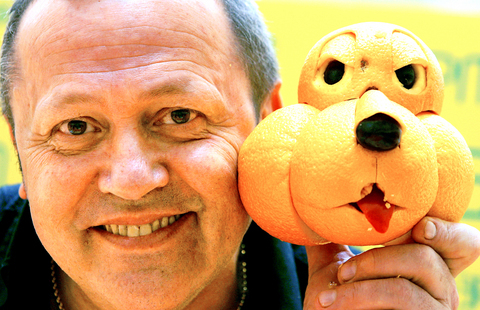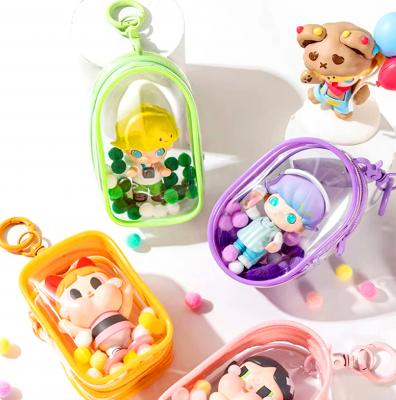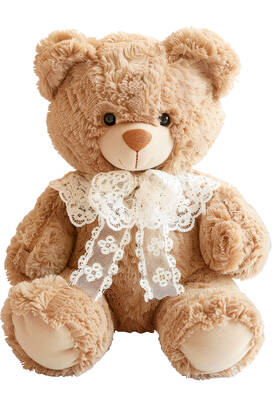Most children know, if you want to have good table manners, one of the most important rules is, "Don't play with your food." But when you aren't actually at the dinner table, sometimes playing with your food can be a great thing.
The man in this picture is an artist from Italy. He doesn't just play with his food, he makes art out of it. Can you tell what kind of fruit he carved to make this dog?
Oranges! In this picture, the sculpture is a dog, but there are many other things you could make from oranges and other kinds of fruit. Can you think of any?

PHOTO : AP
Making art out of food is fun because when you're finished, you can eat your creation! (Kayleen Hartman, Staff writer)
大多數孩童都知道,假如你想要有良好的餐桌禮儀,最重要的規矩之一就是「別拿你的食物來玩」。不過,當你並未坐在餐桌旁時,有時候玩玩食物可說是樂趣無窮。
照片中的人是義大利藝術家。他不只拿食物來玩,還用食物創作藝術。你知道他是用哪一種水果雕刻這隻狗呢?
答案是柳橙!照片中的雕塑品是一隻狗,不過你還可以用柳橙或各種水果創造出許多東西。你想到了什麼嗎?
用食物創作藝術很有趣,因為作品一旦完成,你還可以把你的作品吃掉! (翻譯:賴美君)

If you’ve recently spotted adults parading around with cuddly toys dangling from their designer handbags, your eyes haven’t been deceiving you. The playful trend of adorning bags with cute charms has become popular among people of various ages. Plushies like Labubu and anime and manga characters such as Chiikawa have become must-have accessories that make personal statements. The practice of attaching charms to personal items has been common across cultures throughout history. In ancient civilizations, charms were often used as symbols of protection, good luck, or identity. Fast-forward to more modern times, and style icons like Jane Birkin, a

A: So you’re reading Jin Yong’s martial arts novel again? B: Yup, Jin’s novels are so fascinating, especially the trilogy: “Legends of the Condor Heroes,” “Return of the Condor Heroes,” and “Heaven Sword and Dragon Saber.” A: The late novelist published his first story in 1955, which means this year marks the 70th anniversary of his “wuxia” world. B: Wasn’t an English version of “Legends of the Condor Heroes” also released in 2018? A: Yes, but the debate over the translation of kung fu moves continues — like the evil move “Nine Yin Skeleton Claw.” A: 你又在重讀金庸的武俠小說啦? B:

A: Apart from Jin Yong, the late martial arts novelists Liang Yusheng and Gu Long were also very popular. B: Wasn’t Liang a pioneer of the “new school” wuxia genre in the 20th century? A: Yup, I really like his Tianshan mountain series. All the characters — such as the “White Haired Demoness” — are so vivid. B: The roles in Gu’s books are lively, too — like the “Fragrant Commander” Chu Liuxiang. A: And the TV drama adapted from the Chu Liuxiang series swept across Taiwan in the 1980s, with ratings surging over 70 percent at that time.

Continued from yesterday(延續自昨日) https://www.taipeitimes.com/News/lang If plushie charms are cute little nods to people’s interests, ita bags are full-on declarations. The term “ita” comes from the Japanese word itai, which means “painful” and reflects the overwhelming visual intensity of these bags. An ita bag is essentially a handbag, backpack, or tote meticulously decorated with an extensive collection of merchandise dedicated to a specific character or idol. These bags usually feature a clear plastic window to display carefully arranged pins, badges, keychains, or fan art. Both the interior and exterior may be covered in fandom memorabilia, creating an aesthetic so intense that it’s almost “painful”